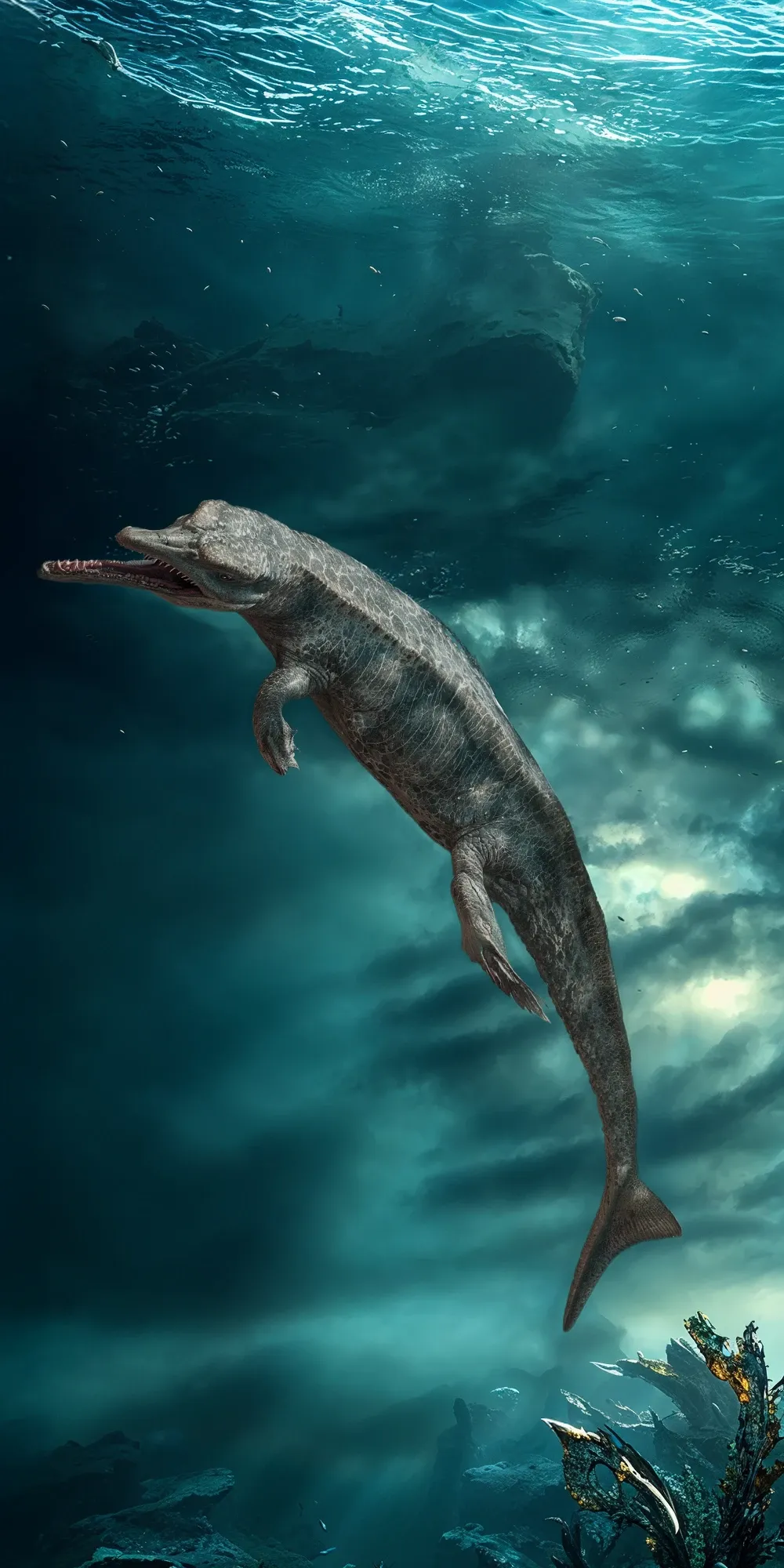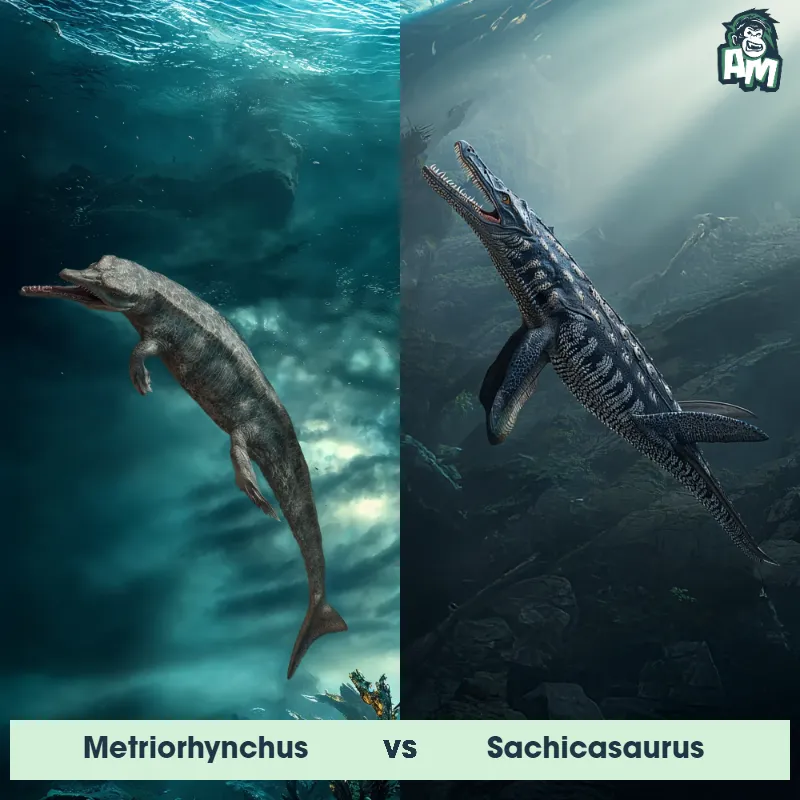The Metriorhynchus
Metriorhynchus, also known as the "sea-crocodile," was a prehistoric marine reptile that lived during the Jurassic period. They had long, streamlined bodies with flippers for efficient swimming and webbed feet for maneuvering in the water. Metriorhynchus had sharp teeth and powerful jaws for hunting fish and other marine prey.

| Metriorhynchus | |
|---|---|
| Size | Up to 10 feet (3 meters) |
| Weight | Unknown |
| Speed | 19-22 mph (30-35 km/h) |
| Key Strength | Powerful jaws |
| Biggest Weakness | Limited mobility on land |
| Scientific Name | Metriorhynchus |
| Family | Metriorhynchidae |
| Habitat | Oceans |
| Geography | Jurassic Period |
| Diet | Fish, cephalopods, marine mammals |
| Lifespan | 22 years - 25 years |

The Metriorhynchus
Metriorhynchus, also known as the "sea-crocodile," was a prehistoric marine reptile that lived during the Jurassic period. They had long, streamlined bodies with flippers for efficient swimming and webbed feet for maneuvering in the water. Metriorhynchus had sharp teeth and powerful jaws for hunting fish and other marine prey.
Fun Fact: Metriorhynchus had a unique adaptation of being able to close its nostrils while underwater to prevent water from entering its nasal passages.
| Metriorhynchus | |
|---|---|
| Size | Up to 10 feet (3 meters) |
| Weight | Unknown |
| Speed | 19-22 mph (30-35 km/h) |
| Key Strength | Powerful jaws |
| Biggest Weakness | Limited mobility on land |
| Scientific Name | Metriorhynchus |
| Family | Metriorhynchidae |
| Habitat | Oceans |
| Geography | Jurassic Period |
| Diet | Fish, cephalopods, marine mammals |
| Lifespan | 22 years - 25 years |
Metriorhynchus Matchups
We use AI to simulate matchups between the Metriorhynchus and other animals. Our simulation considers size, strength, and natural predatory behaviors to determine the most likely outcome.

Can't find the Matchup you want?
Create Your Own MatchupMetriorhynchus: Diet, Predators, Aggression, and Defensive Behaviors
What did Metriorhynchus eat?
Metriorhynchus were carnivorous marine reptiles that primarily fed on fish, ammonites, and other small marine animals. With their streamlined bodies, sharp teeth, and powerful jaws, they were well-equipped for hunting in the water. They likely used their speed and agility to catch their prey.
Did Metriorhynchus have any predators?
As apex predators in their marine environment during the Jurassic period, Metriorhynchus did not have many natural predators. However, they may have been targeted by larger marine reptiles, such as pliosaurs or large sharks. Juvenile Metriorhynchus could also have been vulnerable to predation by other marine creatures.
Were Metriorhynchus aggressive?
Metriorhynchus were known to be relatively aggressive predators, using their sharp teeth and powerful jaws to catch and consume their prey. They were solitary hunters, and their aggressive nature likely played a key role in their success as top predators in their ecosystem.
Did Metriorhynchus fight?
While there is limited evidence of interspecific or intraspecific aggression among Metriorhynchus, it is likely that they would have engaged in territorial disputes or competition for resources. Male Metriorhynchus may have also fought during mating season to establish dominance and access to females.
How did Metriorhynchus defend themselves?
Metriorhynchus likely relied on their speed, agility, and powerful jaws as their primary defense mechanisms. When faced with a threat, they may have used their sharp teeth to inflict damage on potential predators or competitors. Their streamlined bodies and ability to navigate underwater also helped them to escape danger.
What was Metriorhynchus' biggest weakness in a fight?
Despite their formidable hunting abilities, Metriorhynchus may have been vulnerable to larger or more powerful predators, such as pliosaurs or other marine reptiles. Their relatively small size compared to some of the apex predators of the Jurassic seas could have been a disadvantage in a direct confrontation. Additionally, their solitary hunting habits may have left them more exposed to attacks from other predators.
Fun Fact: Despite their appearance, Metriorhynchus were not true crocodiles; they were actually a type of marine crocodyliform.
Fun Fact: Fossil evidence suggests that Metriorhynchus may have given birth to live young instead of laying eggs, making them one of the few reptiles to exhibit this behavior in the ancient seas.












